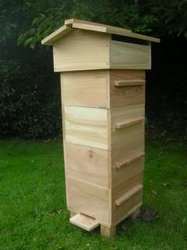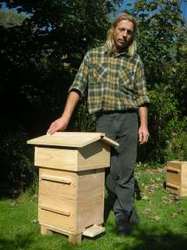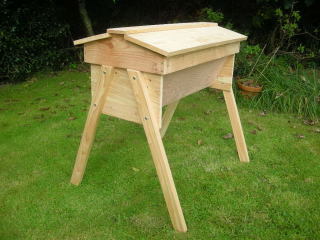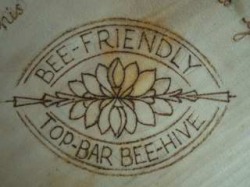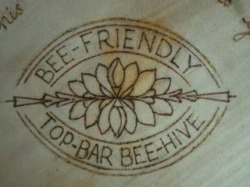The Warre top bar beehive
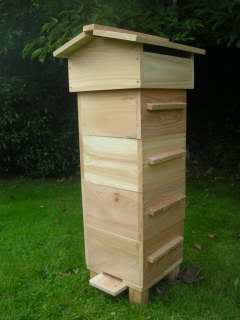
This is the Warre top bar hive.
It is made by Martin Hughes, using locally grown cedar, from sustainably managed wood (fsc). It lasts so well outside it doesn't need preservative. However,there are suggested finishes which are appropriate on the biobees web site though.
They are selling for £240 and this includes 4 boxes, a stand and the roof which has an insulation box ready to fill with your choice of insulation. ( Try woodshavings or straw. )
It comes with a copy of Phil Chandlers wonderful book "The barefoot beekeeper".
At a small extra cost you can have a viewing window added, so you can observe without disturbing.
You can start with a roof, 2 boxes and a base for £190 and then buy extra boxes ( £25 each ) as you need them. However, a nucleus can fill 4 boxes in a year as they extend downwards into the hive.
If you would like to find out how to keep bees please go to http://www.biobees.com/forum. This is a highly informative link into the world of sustainable, "bee-friendly" backyard beekeeping. See the link at the bottom of this page.
It is made by Martin Hughes, using locally grown cedar, from sustainably managed wood (fsc). It lasts so well outside it doesn't need preservative. However,there are suggested finishes which are appropriate on the biobees web site though.
They are selling for £240 and this includes 4 boxes, a stand and the roof which has an insulation box ready to fill with your choice of insulation. ( Try woodshavings or straw. )
It comes with a copy of Phil Chandlers wonderful book "The barefoot beekeeper".
At a small extra cost you can have a viewing window added, so you can observe without disturbing.
You can start with a roof, 2 boxes and a base for £190 and then buy extra boxes ( £25 each ) as you need them. However, a nucleus can fill 4 boxes in a year as they extend downwards into the hive.
If you would like to find out how to keep bees please go to http://www.biobees.com/forum. This is a highly informative link into the world of sustainable, "bee-friendly" backyard beekeeping. See the link at the bottom of this page.
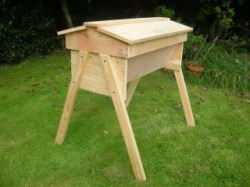
The African Top Bar Beehive.
( Aka The Horizontal Top Bar Hive )
Bee prepared for the 2010 season with a bee-friendly top bar beehive.
These beehives are made with love out of cedar wood, as this requires no weatherproof preservatives to protect it against the elements,it is known as one of the most durable outdoors timbers.
This type of hive is horizontal and easy on your back, it is suitable for wheelchair users. There is no heavy lifting involved.
It also comes with the " Barefoot Beekeeper" book and can be supplied with an insulated viewing window for a small extra cost.
You can become a backyard beekeeper easilly, its not as difficult as you may think. Our hives are £180 plus P+P.
Or why not try making your own!
( Aka The Horizontal Top Bar Hive )
Bee prepared for the 2010 season with a bee-friendly top bar beehive.
These beehives are made with love out of cedar wood, as this requires no weatherproof preservatives to protect it against the elements,it is known as one of the most durable outdoors timbers.
This type of hive is horizontal and easy on your back, it is suitable for wheelchair users. There is no heavy lifting involved.
It also comes with the " Barefoot Beekeeper" book and can be supplied with an insulated viewing window for a small extra cost.
You can become a backyard beekeeper easilly, its not as difficult as you may think. Our hives are £180 plus P+P.
Or why not try making your own!
Bees in action

Here are the bees on a top bar they have covered with a comb. It is easier for the bees to keep this shaped box at the perfect temperature. By making their own wax combs they design the interior in a way that is easier to keep warm and to access their honey stores in the winter. When they control the production of the combs, as they can without a pre-formed foundation, they vary the sizes of the cells. This affects the size of the larvae. It is interesting to note that the varoa mite prefer larger bees!
Bees control the temperature of the hives with the beating of their wings and like to maintain it at a steady temperature, 94 degrees, this is close to the human body temperature. It is also noted that the varoa mite cannot survive above 92 degrees. Therefore, we can see how important it is not to disturb the hive environment by frequently lifting off the lid and disturbing the propolis seals if we can avoid it. These Top Bar hives are designed for minimal interferance.
Bees control the temperature of the hives with the beating of their wings and like to maintain it at a steady temperature, 94 degrees, this is close to the human body temperature. It is also noted that the varoa mite cannot survive above 92 degrees. Therefore, we can see how important it is not to disturb the hive environment by frequently lifting off the lid and disturbing the propolis seals if we can avoid it. These Top Bar hives are designed for minimal interferance.
Information about bee-keeping
Click on this link to find the barefoot bee-keepers very informative web site.
